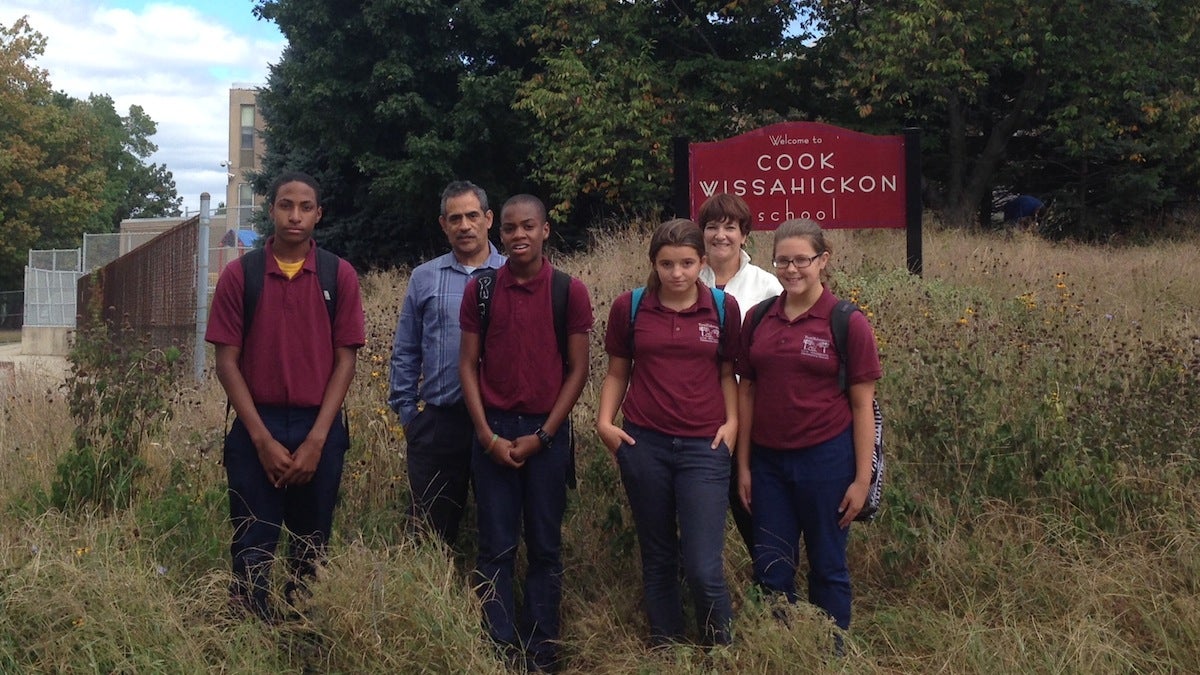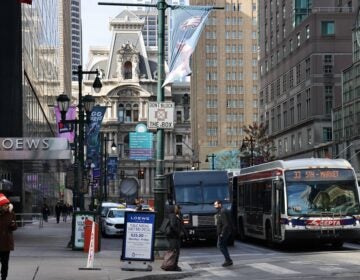Cook-Wissahickon front-lawn look draws concern, then cooperation from neighbors

English teacher Jose Ramos and Wissahickon Sustainability Council cofounder Jeanne Ortiz stand with eighth graders in the school's native plant meadow. (Neema Roshania/WHYY)
Walk down Salaignac Street in Roxborough and you might be surprised by what looks like weeds and untamed grass in front of Cook-Wissahickon School.
In reality, it’s a nearly $40,000 venture.
“It looked overgrown and not particularly pleasing,” says Jon Miller, president of the neighborhood civic associaton, Wissahickon Citizen’s Association.
Jeanne Ortiz, a former parent and cofounder of the Wissahickon Sustainability Council — the group responsible for the school’s ungroomed front-lawn meadow — says it’s a refrain she often hears.
“‘There’s no money for maintenance at Cook!’ What’s happening at Cook?'”
The meadow — full of plants and flowers native to eastern Pennsylvania that were planted in 2012 — is now “grown up,” according to Ortiz, and offers what typical lawns and potted flower plants can’t.
“It’s a home. It’s a home for wildlife and it’s filtering air, cleaning drinking water and all sorts of good things,” says Ortiz, adding that the native plants on the school grounds also extend the natural habitat available to wildlife from nearby Fairmount Park.
Curriculum tie
Jose Ramos is an English teacher at Cook-Wissahickon who has been involved in the sustainability council for three years.
He weaves his work with the council into his classes, like having his students write love letters to water, but believes the impact of the council’s work can extend into every part of their education.
“Kids don’t get out enough so we have to expose them to being outdoors. It gives us the opportunity to give them hands-on learning. Now they can actually see why they are learning this and what’s the purpose behind it,” he says.
A blueprint for the neighborhood
Ortiz, who works an urban planner with Audubon Pennsylvania, says the ultimate goal of the council extends beyond just the property of the school.
“This is really a model for what people can do in their own backyard,” she says. “All of these natural resources have been lost but if we each individually do something like this we can recreate all of these spots and reconnect the green fabric of the city.”
That’s where neighborhood groups like WICA and Destination Schuylkill River hope to step in.
After Ortiz presented in front of a group of neighbors at a WICA meeting in early September, Miller says residents jumped at the opportunity to participate once they understood the project.
“We’re willing to get our hands dirty and do whatever needs to be done,” says Miller. “There are probably a million ways we can contribute that I haven’t even considered yet.”
As for Destination Schuylkill River — a group dedicated to connecting the neighborhoods along the Schuylkill — they hope to replicate similar native-plant initiatives at other Northwest Philadelphia schools including Dobson Elementary School and W.B. Saul High School.
“I was really impressed with what Cook had done,” Kay Sykora, director of Destination Schuylkill River, says. “It engaged people — both parents and teachers — in something that is really helpful for educational purposes.”
Now that they have received a grant from the Philadelphia Water Department, Sykora says they hope to work in up to three schools a year on initiatives similar to those at Cook-Wissahickon.
The plan will differ from school to school based on their needs and resources. At Dobson, for example, Sykora explains the plan will likely involve an outdoor classroom space and watershed tools.
Looking ahead
Before the meadow at Cook-Wissahickon matured, the sustainability council had put into place a series of smaller projects, including a native magnolia grove and three raised beds for students to plant in.
The creation of the meadow was funded by the Schuylkill River Restoration Fund and the Pennsylvania Horticultural Society’s Tree Tenders program, who sponsored the 34 trees planted along the sidewalk as part of the effort.
Plans going forward include building an outdoor classroom for students and science classes to use.
The Schuylkill Center for Environmental Education plans to bring in curriculum for use by the school.
Plans for a second meadow are already in the works. The council also hopes to pull up the pavement in the playground to green the space and build a rain garden. Ortiz would even like to see a green roof installed one day.
For Ortiz, the benefits of the greener space are as simple as seeing a native goldfinch fly by.
“I’ve been here for 10 years and I’ve never seen a goldfinch until last spring when I saw one flying around here. It was so exciting.”
WHYY is your source for fact-based, in-depth journalism and information. As a nonprofit organization, we rely on financial support from readers like you. Please give today.




